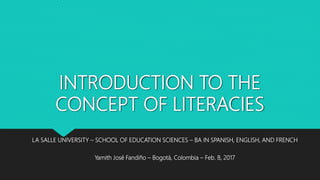
Introduction to the concept of literacies
- 1. INTRODUCTION TO THE CONCEPT OF LITERACIES LA SALLE UNIVERSITY – SCHOOL OF EDUCATION SCIENCES – BA IN SPANISH, ENGLISH, AND FRENCH Yamith José Fandiño – Bogotá, Colombia – Feb. 8, 2017
- 2. INTRODUCTION
- 3. Considerations How literacy fits in human history - Language as an innate, natural capacity to make and understand meaning. - When language becomes symbols, it takes a manufactured form that can be transported, that lasts. - First, we had oral, visual, and gestural communication. - Then, we had reading and writing as an artifact, a piece of technology. - Now, we have new ways of communicating simultaneously through different modes. - 3 historical moments or phases of globalization.
- 5. First languages Humans as a species = creative, but isolated Different ways of expressing meanings. First languages Small populations = Unique languages with - large differences among themselves - internal differences (age, gender, clan) - Dynamic = Complex cultures and epistemologies. - Logic = My specific relationship with the world is the specific way in which I speak about the world. Extraordinary multilingualism = Lingua francas Speak 3, 4 or 5 languages. Great dynamism = No dictionaries, grammars or literacy practices. Renaming as result of changes in meaning (life, seasons, relationships). Immense multimodality = Elaborate symbolic systems Images, body paints, dances, gestures.
- 7. Starting to write Writing = a restrictive form of meaning making. - Spreading of first language systems with some form of writing (Chinese in Asia, Mesopotamia in Egypt, Aztecs in Central America, etc.) Writing = 1. Elites and religion Inequality because just a few had that knowledge. 2. Control Canonical texts and standardization. 3. Uses List properties and taxes. Progressive advance of writing = the death of small languages. - Modernity = The rise of nation states Individuals should be able to communicate with strangers. Common languages = Strong political agendas.
- 8. Starting to write Writing = Institutionalize textbook-based education system. knowledge that mattes. Rules and skills that are needed. Ways of testing. School = A place to teach a standard language that everybody shares. Not going and learning that language means marginalization.
- 10. Digital literacies Digitalization = A means of manufacturing meanings Signs, images, sounds produced by the same tools. Organization, work, relationships change. Challenging written language as a privilege form of meaning making. Second half of the 20th C Photolithography = Images and texts together. New visual and oral modes = Telegraph, telephone, radio, TV = Communication across distances.
- 12. Digital literacies The Internet Web 1.0 = a transmission model of putting messages in the world through images and texts together Searching, navigating, looking. Web 2.0 = Interactive and dialogical model Primarily oral and in real time. New media Synaesthetic (Switching between modes) Images are predominant. Communication anywhere, any time. New power and relationships = Social media, news feeds, video instruction, apps. Receive an deliver information in multimodal ways.
- 13. Digital literacies Multimodality Wherever we are, there is a mixture and interleaving of images, texts, colors, sounds in media. Writing Originally, a privilege of an elite = The priest, the lords Inequality Modern times = Journalists, writers, specialists Makers of most literate culture and the others were consumers. Now = We are ALL readers and writers of multimodal texts. No passive receivers, but active communicators. English, Spanish, Arabic altogether in life-like spaces.
- 15. Digital literacies Are educators prepared to enable learners to make meaning through new technologies? Across all disciplines? (Science, Maths, Languages, etc.) Across all social domains (Personal, family, friendship, work, love, academia, etc.) What does it mean to prepare anyone with a repertoire of digital meaning making modes? What values? What skills? What sensibilities? How to do it successfully?
- 16. Reference Kalantzis, M., & Cope, B. (2016). Literacies. Cambridge: Cambridge University Press.
